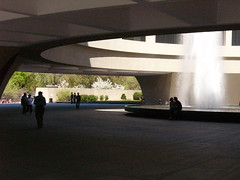Late Sunday morning we headed into D.C. again, but at the Smithsonian Metro station Gail hopped off the train, while I rode on for a sidebar of my own - The National Postal Museum.It's located in the old Post Office building next to Union Station, which is a grand place that I will have to go back and revisit.
The Postal Museum is not that big, and lightly attended, as you might imagine. It takes up one floor and a courtyard, and documents the U.S. Postal Service of course; most of the exhibits would only be of interest to philatelists. (Among them: "The History of the Envelope!" Whee!) But in the courtyard they have three old airplanes suspended from the ceiling; in the center is an Air Mail D.H. 4 biplane, the significance of which I describe in my photo caption. It wouldn't draw much attention in the Air & Space Museum, just an old dun-colored biplane with no guns or bombs or famous pilots. So it resides quietly here, along with an old mail truck and a horse-drawn delivery wagon; I photographed it from every angle, in my own unique awe. I've read everything I could find about the exploits of the Air Mail fliers, and I imagined what it must have been like to pilot a machine like this, through all kinds of weather, across the nation. It was difficult and dangerous, and I'm glad I fly with the benefit of modern technology - innovations these pilots came up with to save their own necks. From everything that I've read, most of them did it for their love of flying, and I guess that's why I feel a kinship with them.
Having figured out the Metro system, I gave it a miss and walked back to the National Mall, crossing in front of the Capitol dome. My path to the Hirshhorn Museum, where I was to meet Gail, took me by the Museum of the American Indian, which I had never seen. It opened on September 21, 2004, and is a fascinating building to behold. The architecture is like a stylized Pueblo village; it was designed with Native American consultants, and incorporates a creek that was in place at the site. For such a large building, it is very organic; almost no straight lines, and well integrated with the ground beneath it. The redirected creek flows down the side of the building and splashes over massive natural rocks, before flowing around the side of the building.
Continuing past the Air & Space Museum (which I've explored many times, natch) I came to the Hirshhorn, one of the Smithsonian's art museums, this one devoted to contemporary art. It too is an architectural wonder, built as an upright tube; the gallery floors are circular, and consist of an inner ring looking on the courtyard and an outer with natural light. The whole building seems to float in the air, as it is built on tapered pillars that lift it a full two stories off the street level; the space created under and around the building is unique and ultra-modern, yet very comfortable. in the center is a tall fountain, and sculpture gardens line the perimeter. I walked around it once, then went inside to find Gail, who was just finishing her trip through the exhibits.
We went next door to the Air & Space Museum for the last hour before it closed; Gail explored the machines that interested her, and I revisited my old favorites. Then we finished the day on the Mall in front of the Capitol, trying to snap photos of the seagulls and exploring the older fountains and sculptures at this end.
We will surely be back; we have only begun to explore all the sights in Washington. What's not to love - clean public transit, free museums and tapas!
